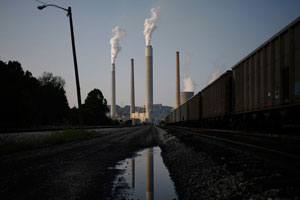Supreme Court Rules Against EPA on Power-Plant Emissions Rule

The Obama administration didn’t adequately consider the billions of dollars in costs before issuing a rule designed to cut hazardous emissions from 460 coal-fired power plants, the U.S. Supreme Court ruled.
The 5-4 decision calls into question an Environmental Protection Agency rule that targets mercury and acid gases. It leaves open the possibility that the agency might be able to enforce its rule on the basis of a new analysis.
The power industry had suffered a series of defeats at the Supreme Court in recent years. The June 29 ruling was the last of the court’s 2014-2015 term.
The case centered on a 2011 EPA regulation that aims to curb birth defects, heart disease and premature deaths. The rule, which had just begun taking effect, has forced companies to close aging facilities or install expensive scrubbing equipment.
Mercury, the main pollutant targeted by the rule, accumulates in fish and can cause neurological and kidney disorders when people consume those fish.
The Clean Air Act says EPA may regulate mercury and other hazardous power-plant pollutants if the agency concludes action is “appropriate and necessary.”
The question for the Supreme Court was whether the agency must consider the cost before deciding to regulate. The Obama administration contended that the Clean Air Act requires that costs be taken into account only at a later stage — when EPA is deciding the extent of the regulation.
Writing for the court, Justice Antonin Scalia said that was an unreasonable interpretation of the statute.
“Agencies have long treated cost as a centrally relevant factor when deciding whether to regulate,” Scalia wrote. “Consideration of cost reflects the understanding that reasonable regulation ordinarily requires paying attention to the advantages and the disadvantages of agency decisions.”
The court divided along familiar lines. Justices Ruth Bader Ginsburg, Stephen Breyer, Sonia Sotomayor and Elena Kagan dissented.
It now will be up to a lower federal court to decide what EPA must do and whether the rule must be scrapped altogether.
“I think the D.C. Circuit will have to throw out the existing rule until the EPA goes back and decides whether regulating power plants is appropriate and necessary when considering the rule’s cost,” said Brian Potts, a lawyer specializing in the Clean Air Act.
Analysts say it’s unlikely that utilities will reverse already announced plans to close old coal plants rather than install the expensive equipment necessary to clean up toxins coming out the smokestack.
Other pending federal rules and state requirements could force them to proceed with their cleanup plans nonetheless. Yet some companies could delay plans to install that equipment or choose not to run scrubbers they already have paid to put in place, said Sanjay Narayan, a lawyer for the Sierra Club.
“You lose a lot of public health benefits, but you don’t save companies a lot of money,” he said.
The country’s biggest coal producer, Peabody Energy Corp., rose more than 8% to more than $2.50 a share.
The biggest clean-air fight may be still to come after the Obama administration issues its final plan to tackle climate change.




